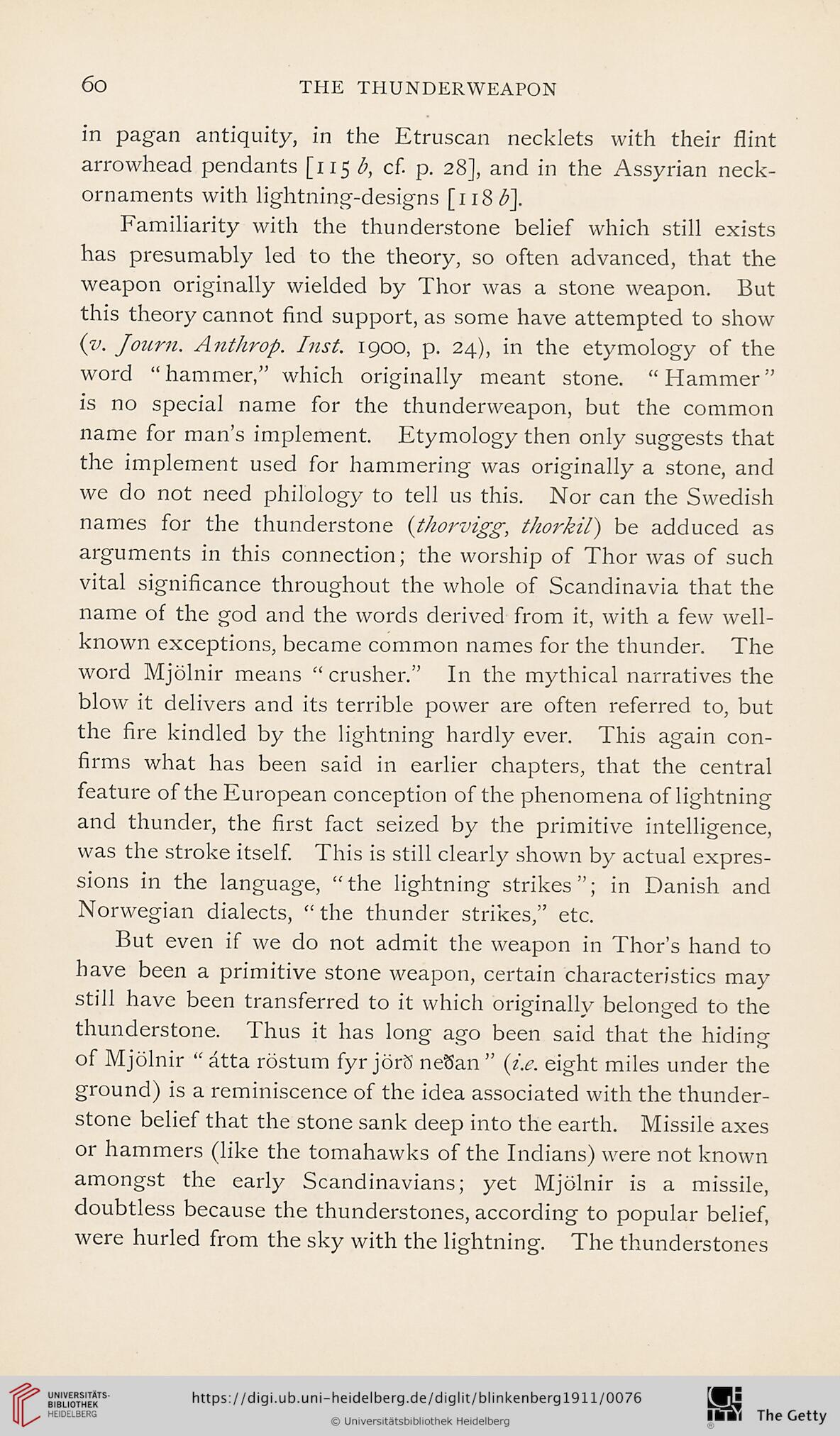6o
THE THUNDERWEAPON
in pagan antiquity, in the Etruscan necklets with their flint
arrowhead pendants [115 b, cf. p. 28], and in the Assyrian neck-
ornaments with lightning-designs [ 118 b].
Familiarity with the thunderstone belief which still exists
has presumably led to the theory, so often advanced, that the
weapon originally wielded by Thor was a stone weapon. But
this theory cannot find support, as some have attempted to show
(v. Journ. Anthrop. Inst. 1900, p. 24), in the etymology of the
word “hammer,” which originally meant stone. “Hammer”
is no special name for the thunderweapon, but the common
name for man’s implement. Etymology then only suggests that
the implement used for hammering was originally a stone, and
we do not need philology to tell us this. Nor can the Swedish
names for the thunderstone (thorvigg, thorkil) be adduced as
arguments in this connection; the worship of Thor was of such
vital significance throughout the whole of Scandinavia that the
name of the god and the words derived from it, with a few well-
known exceptions, became common names for the thunder. The
word Mjolnir means “ crusher.” In the mythical narratives the
blow it delivers and its terrible power are often referred to, but
the fire kindled by the lightning hardly ever. This again con-
firms what has been said in earlier chapters, that the central
feature of the European conception of the phenomena of lightning
and thunder, the first fact seized by the primitive intelligence,
was the stroke itself. This is still clearly shown by actual expres-
sions in the language, “the lightning strikes”; in Danish and
Norwegian dialects, “ the thunder strikes,” etc.
But even if we do not admit the weapon in Thor’s hand to
have been a primitive stone weapon, certain characteristics may
still have been transferred to it which originally belonged to the
thunderstone. Thus it has long ago been said that the hiding
of Mjolnir “ atta rostum fyr jorS neSan ” (i.e. eight miles under the
ground) is a reminiscence of the idea associated with the thunder-
stone belief that the stone sank deep into the earth. Missile axes
or hammers (like the tomahawks of the Indians) were not known
amongst the early Scandinavians; yet Mjolnir is a missile,
doubtless because the thunderstones, according to popular belief,
were hurled from the sky with the lightning. The thunderstones
THE THUNDERWEAPON
in pagan antiquity, in the Etruscan necklets with their flint
arrowhead pendants [115 b, cf. p. 28], and in the Assyrian neck-
ornaments with lightning-designs [ 118 b].
Familiarity with the thunderstone belief which still exists
has presumably led to the theory, so often advanced, that the
weapon originally wielded by Thor was a stone weapon. But
this theory cannot find support, as some have attempted to show
(v. Journ. Anthrop. Inst. 1900, p. 24), in the etymology of the
word “hammer,” which originally meant stone. “Hammer”
is no special name for the thunderweapon, but the common
name for man’s implement. Etymology then only suggests that
the implement used for hammering was originally a stone, and
we do not need philology to tell us this. Nor can the Swedish
names for the thunderstone (thorvigg, thorkil) be adduced as
arguments in this connection; the worship of Thor was of such
vital significance throughout the whole of Scandinavia that the
name of the god and the words derived from it, with a few well-
known exceptions, became common names for the thunder. The
word Mjolnir means “ crusher.” In the mythical narratives the
blow it delivers and its terrible power are often referred to, but
the fire kindled by the lightning hardly ever. This again con-
firms what has been said in earlier chapters, that the central
feature of the European conception of the phenomena of lightning
and thunder, the first fact seized by the primitive intelligence,
was the stroke itself. This is still clearly shown by actual expres-
sions in the language, “the lightning strikes”; in Danish and
Norwegian dialects, “ the thunder strikes,” etc.
But even if we do not admit the weapon in Thor’s hand to
have been a primitive stone weapon, certain characteristics may
still have been transferred to it which originally belonged to the
thunderstone. Thus it has long ago been said that the hiding
of Mjolnir “ atta rostum fyr jorS neSan ” (i.e. eight miles under the
ground) is a reminiscence of the idea associated with the thunder-
stone belief that the stone sank deep into the earth. Missile axes
or hammers (like the tomahawks of the Indians) were not known
amongst the early Scandinavians; yet Mjolnir is a missile,
doubtless because the thunderstones, according to popular belief,
were hurled from the sky with the lightning. The thunderstones




